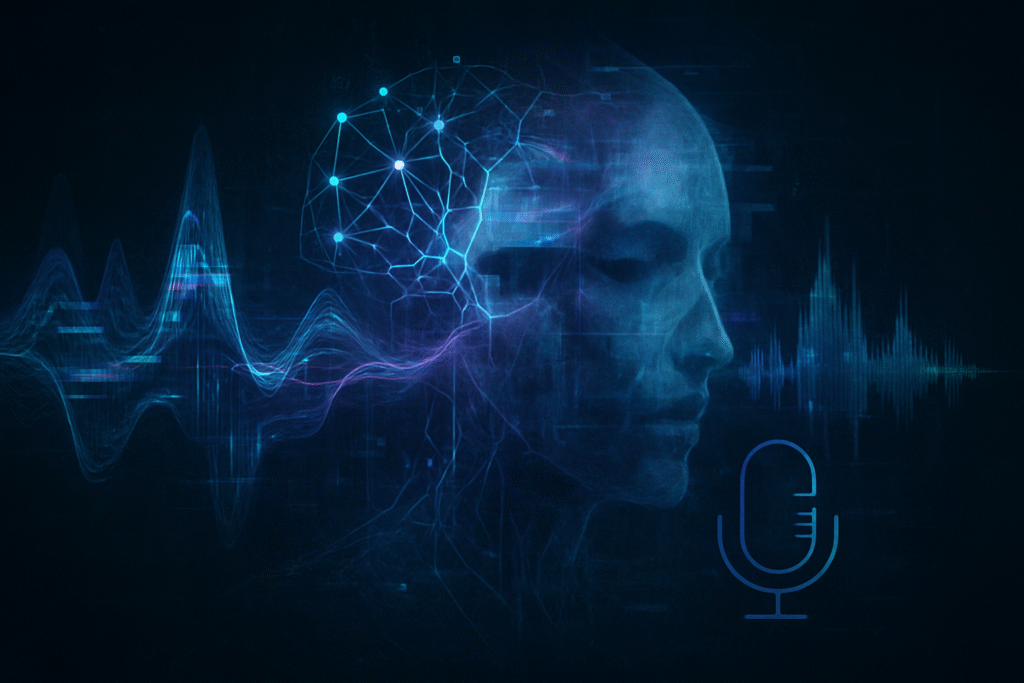
Recent advancements in AI-generated deepfake audio technology have ushered in an era where distinguishing between genuine and synthetic voices is becoming increasingly challenging, even for the human ear. This significant leap in realism, driven by sophisticated deep learning models, presents a dual-edged sword: offering promising applications in various fields while simultaneously opening a Pandora's box of security risks and profound ethical dilemmas. The immediate significance of this evolution is palpable, with malicious actors already leveraging these capabilities to orchestrate highly convincing phone call frauds, eroding trust in digital communications and demanding urgent attention from both technology developers and regulatory bodies.
The ease with which highly realistic voice clones can now be generated from mere seconds of audio has drastically lowered the barrier to entry for potential misuse. While beneficial applications range from personalized virtual assistants and creative content generation to aiding individuals with speech impairments, the darker implications are rapidly escalating. The weaponization of deepfake audio for phone call fraud, often termed "vishing," is particularly alarming, as scammers exploit emotional connections and urgency to coerce victims into financial transactions or divulging sensitive personal information, making this a critical concern for businesses and individuals alike, including enterprise solution providers like TokenRing AI.
The Uncanny Valley of Sound: A Technical Deep Dive into Voice Synthesis
The current wave of AI-generated deepfake audio largely hinges on the refinement of two primary techniques: Text-to-Speech (TTS) and Voice Conversion (VC). Modern TTS systems, powered by neural networks, can now synthesize speech from written text with an unprecedented level of naturalness, mimicking human intonation, rhythm, and emotion. Voice Conversion, on the other hand, takes an existing voice and transforms it to sound like a target voice, requiring minimal audio samples of the target to achieve a highly convincing impersonation. The crucial advancement lies in the integration of sophisticated deep learning architectures, such as Generative Adversarial Networks (GANs) and Variational Autoencoders (VAEs), which have significantly improved the fidelity and emotional range of synthetic voices.
What sets these new approaches apart from their predecessors is their ability to perform "few-shot learning" or "zero-shot learning." Where older systems required extensive datasets of a target voice, contemporary models can generate a highly believable clone from as little as 3-5 seconds of audio, or even synthesize a new voice style without any prior examples. This dramatically reduces the effort and resources needed for malicious actors to create convincing fakes. Furthermore, the increasing availability of open-source models and user-friendly online tools has democratized this technology, making it accessible to individuals without specialized technical expertise, a stark contrast to the complex, resource-intensive processes of the past.
Initial reactions from the AI research community and industry experts range from awe at the technical prowess to grave concern over the ethical ramifications. While acknowledging the potential for positive applications in accessibility and entertainment, there's a growing consensus that the "deepfake arms race" between generation and detection technologies is intensifying. Experts highlight the urgent need for robust detection mechanisms and ethical guidelines, fearing that the widespread proliferation of undetectable deepfakes could irrevocably erode trust in digital media and personal communications. The FCC has already taken a step by classifying AI-generated voice calls as illegal robocalls without consent, underscoring the severity of the threat.
Corporate Crossroads: Navigating the Deepfake Landscape
The burgeoning reality of highly realistic AI deepfake audio presents a complex and multifaceted challenge, simultaneously creating new opportunities and existential threats for AI companies, tech giants, and startups. Companies specializing in cybersecurity, particularly those focused on fraud detection and digital forensics, stand to significantly benefit. Firms like TokenRing AI, which delivers enterprise-grade solutions for intelligent threat detection and response, are strategically positioned to offer critical countermeasures against sophisticated AI-driven deepfake attacks. Their focus on identifying such threats at unprecedented speeds, potentially enhanced by quantum technology, highlights a growing market for advanced security solutions.
For major AI labs and tech companies (NASDAQ: GOOGL, NASDAQ: MSFT, NASDAQ: AMZN), the competitive implications are substantial. While they are often at the forefront of developing these generative AI capabilities, they also bear the responsibility of mitigating their misuse. This necessitates significant investment in deepfake detection research, robust ethical AI frameworks, and responsible deployment practices. Companies that can effectively integrate advanced detection capabilities into their platforms and offer verifiable authentication methods for voice-based interactions will gain a strategic advantage, fostering trust in their services. Conversely, those that fail to address these concerns risk reputational damage and regulatory scrutiny.
The potential disruption to existing products and services is profound. Voice authentication systems, once considered a convenient security measure, are now under intense pressure to evolve beyond simple voiceprint matching to incorporate liveness detection and more sophisticated AI-based anomaly recognition. Call centers and customer service operations face increased vulnerability to social engineering attacks using cloned voices, necessitating enhanced employee training and technological safeguards. Startups focused on developing watermarking technologies for AI-generated content, or those offering real-time deepfake detection APIs, are emerging as crucial players in this evolving landscape, disrupting traditional security paradigms and creating new market segments focused on digital authenticity and trust.
The Broader AI Canvas: Trust, Misinformation, and the Human Element
The rise of advanced AI-generated deepfake audio fits squarely into the broader landscape of generative AI advancements, echoing the concerns previously raised by deepfake video and large language models. It underscores a critical trend: AI's increasing ability to convincingly mimic human creativity and communication, pushing the boundaries of what is technologically possible while simultaneously challenging societal norms and trust. This development is not merely a technical breakthrough but a significant milestone in the ongoing discourse around AI safety, ethics, and the potential for technology to be weaponized for widespread misinformation and deception.
The impacts are far-reaching. Beyond financial fraud, deepfake audio poses a severe threat to public trust and the integrity of information. It can be used to spread fake news, manipulate public opinion during elections (as seen with AI-generated robocalls impersonating political figures), damage reputations through fabricated statements, and even create diplomatic incidents. The erosion of trust in audio evidence has profound implications for journalism, legal proceedings, and personal communications. Privacy violations are also a major concern, as individuals' voices can be cloned and used without their consent, leading to identity theft and unauthorized access to sensitive accounts.
Comparisons to previous AI milestones, such as the initial breakthroughs in deepfake video or the emergence of highly articulate large language models, reveal a consistent pattern: rapid technological advancement outpaces ethical considerations and regulatory frameworks. While deepfake video ignited concerns about visual manipulation, deepfake audio adds an insidious layer, exploiting the deeply personal and often unverified nature of voice communication. The challenge lies not just in detecting fakes, but in rebuilding a framework of trust in an increasingly synthesized digital world, where the authenticity of what we hear can no longer be taken for granted.
The Horizon of Sound: Future Developments and the Detection Arms Race
Looking ahead, the trajectory of AI-generated deepfake audio points towards an escalating arms race between synthesis capabilities and detection technologies. In the near-term, we can expect the quality and sophistication of deepfake audio to continue improving, making it even harder for human listeners and current automated systems to identify fakes. This will likely involve more nuanced emotional expression, better handling of background noise, and the ability to seamlessly integrate cloned voices into real-time conversations, potentially enabling more dynamic and interactive vishing attacks. The proliferation of user-friendly tools will also continue, making deepfake generation more accessible to a wider array of malicious actors.
On the horizon, potential applications extend into areas such as hyper-personalized education, advanced accessibility tools for individuals with severe speech impediments, and even historical voice preservation. However, these positive use cases will run parallel to the continued weaponization of the technology for sophisticated fraud, psychological manipulation, and state-sponsored disinformation campaigns. We may see AI systems trained to not only clone voices but also to generate entire fraudulent narratives and execute multi-stage social engineering attacks with minimal human intervention.
The primary challenge that needs to be addressed is the development of robust, real-time, and scalable deepfake detection mechanisms that can stay ahead of the rapidly evolving generation techniques. This will likely involve multi-modal AI systems that analyze not just audio characteristics but also contextual cues, behavioral patterns, and even physiological markers. Experts predict a future where digital watermarking of authentic audio becomes standard, alongside advanced biometric authentication that goes beyond mere voice recognition. Regulatory frameworks will also need to catch up, establishing clear legal definitions for AI-generated content, mandating disclosure, and imposing severe penalties for misuse. The ongoing collaboration between AI researchers, cybersecurity experts, and policymakers will be crucial in navigating this complex landscape.
The Auditory Revolution: A Call to Vigilance
The rapid advancements in AI-generated deepfake audio mark a pivotal moment in the history of artificial intelligence, underscoring both its transformative potential and its inherent risks. This development is not merely a technical curiosity but a profound shift in the digital landscape, challenging our fundamental understanding of authenticity and trust in auditory communication. The ability to convincingly clone voices with minimal effort has opened new avenues for creativity and accessibility, yet it has simultaneously unleashed a powerful tool for fraud, misinformation, and privacy invasion, demanding immediate and sustained attention.
The significance of this development cannot be overstated. It represents a critical escalation in the "deepfake arms race," where the capabilities of generative AI are pushing the boundaries of deception. The implications for phone call fraud are particularly dire, with projected financial losses in the tens of billions, necessitating a paradigm shift in how individuals and enterprises, including those leveraging solutions from TokenRing AI, approach digital security and verification. The erosion of trust in audio evidence, the potential for widespread disinformation, and the ethical dilemmas surrounding consent and identity manipulation will reverberate across society for years to come.
As we move forward, the coming weeks and months will be crucial. We must watch for the emergence of more sophisticated deepfake attacks, alongside the development and deployment of advanced detection technologies. The regulatory landscape will also be a key area of focus, as governments grapple with establishing legal frameworks to govern AI-generated content. Ultimately, navigating this auditory revolution will require a concerted effort from technologists, ethicists, policymakers, and the public to foster digital literacy, demand transparency, and build resilient systems that can discern truth from the increasingly convincing echoes of deception.
This content is intended for informational purposes only and represents analysis of current AI developments.
TokenRing AI delivers enterprise-grade solutions for multi-agent AI workflow orchestration, AI-powered development tools, and seamless remote collaboration platforms.
For more information, visit https://www.tokenring.ai/.






